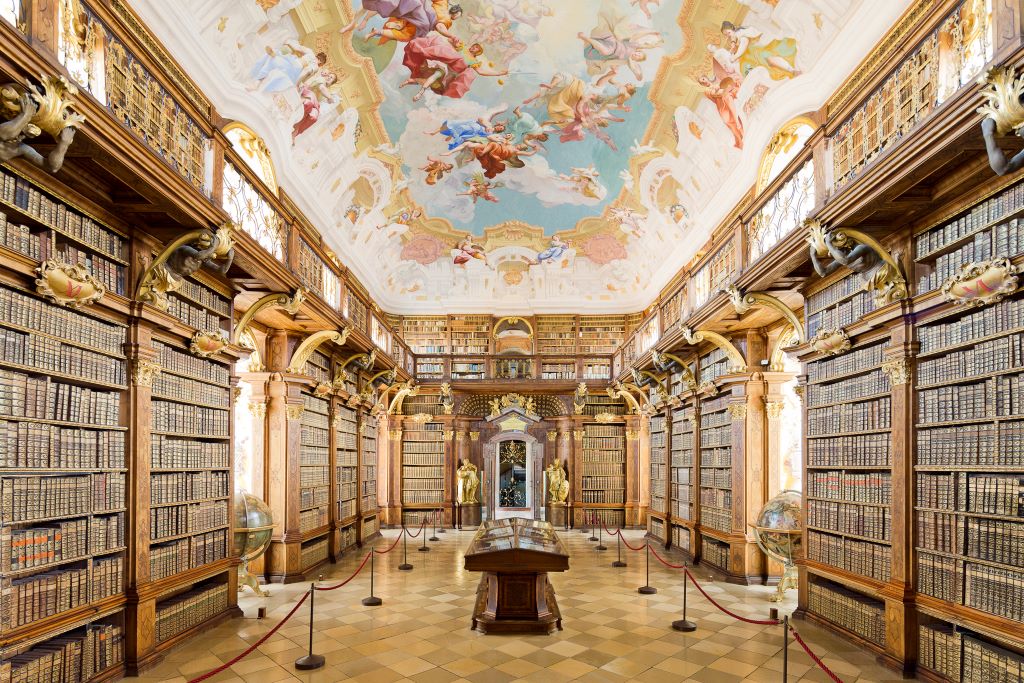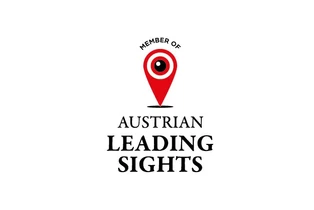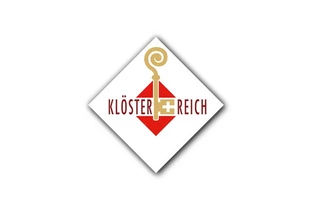Melk Abbey - the monastery complex at a glance
Welcome!
Melk Abbey fascinates people from all over the world, as it is a spiritual, intellectual, and cultural center. Austria’s History is omnipresent here: the stupendous building was erected according to plans by master builder Jakob Prandtauer and ranks among the most outstanding examples of Baroque architecture. It is a place where Benedictine spirituality can be felt and experienced. A visit of world-famous Melk Abbey represents a highlight of every excursion or journey to Austria.
The abbey grounds are spacious, and many areas can be visited: the interactive map offers a complete overview and below you find information about the most important stops during your visit.
Abbey Visit
Melk abbey is closely linked to Austria’s History. Many rulers visited the monastery, and the rooms which can be reached via the Imperial Staircase were reserved for noble guests. Today visitors find an exhibition there.
Imperial Staircase
The entrance to the Imperial Wing is the Imperial Staircase which is situated in the Southwestern corner of the Prelate’s Courtyard. The splendid staircase features limestone columns and rich stucco decorations. Two allegorical figures represent Perseverance and Courage – the motto of Emperor Charles VI. The stuccoed ceiling shows the double-headed eagle.
Imperial Corridor
The Imperial Corridor on the first floor is 196 m / 643 ft. long, which spans nearly the whole length of the Southern Wing. The paintings on the walls depict the Austrian rulers of the Babenberg and the Habsburg families. For the most part they were created by Franz Joseph Kremer, a disciple of Paul Troger, in the 18th century.
Imperial Rooms
The Imperial Rooms along the Imperial Corridor now house the abbey museum.
“Hospites tamquam Christus suscipiantur” (Guests should be received as Christ would be)
“Et omnibus congruus honor exhibeatur” (And to each the honor given which is his due)
inscriptions above the doors of the Marble Hall
The ceiling fresco by Paul Troger (1731) shows, in the center, Pallas Athena on a chariot drawn by lions as a symbol of wisdom and moderation. Hercules can be seen to her left, symbolizing the force necessary to conquer the three-headed hound of hell, night, and sin. Both Pallas Athena and Hercules allude to Emperor Karl VI, who liked to be celebrated as a successor to the Roman emperors in the Hercules legend. The guest is shown the essence of the House of Habsburg: The ruler brings the people from dark to light, from evil to good.
The inscriptions above the doors are quotes from the Rule of Saint Benedict and refer to the purpose of the room: “Hospites tamquam Christus suscipiantur” (Guests should be received as Christ would be) and “Et omnibus congruus honor exhibeatur” (And to each the honor given which is his due). The Marble Hall served as a dining hall for the imperial family and other distinguished guests, as well as a festival hall.
The doorframes are made of genuine marble from Adnet and Untersberg (in the province of Salzburg), whereas the walls are of marble stucco.
The architectural painting on the ceiling fresco was created by Gaetano Fanti.
The balcony is the terrace connecting the Marble Hall and the library is inextricably linked with the characteristic and world-famous view of the Baroque buildings from the West.

The world-famous abbey library is one of the visit’s highlights. Guests can see the two historical rooms. You find more information about Melk abbey’s library here.
"ABSIT GLORIARI NISI IN CRUCE"(Glory is to be found only in the cross)
inscription above the entrance to the Benedict Hall
The high point of the baroque monastery is the church. Following the wishes of the abbot and monastic community, this is intended to make the religious purpose of the entire construction and its orientation towards God clearly visible. The leitmotif “ABSIT GLORIARI NISI INCRUCE” (Glory is to be found only in the cross) is found in the inscription over the Benedict Hall at the beginning of the tour, and continues through the abbey to the church, in whose splendor the glory of the cross is clear.
Originally only a baroquization of the abbey church was planned. However, after 1701, at Abbot Berthold Dietmayr’s instigation, a complete reconstruction of the church took place following plans by Jakob Prandtauer. The men acquired for the artistic decoration of the church were prominent masters in their fields: Antonio Beduzzi (interior design, sketches for the frescoes), Johann Michael Rottmayr (frescoes, altar paintings), Paul Troger (altar paintings), Giuseppe Galli-Bibiena (designs for the pulpit and high altar), Lorenzo Mattielli (design for the sculptures), and Peter Widerin (sculptures).
The left side altar in the transept contains the mortal remains of St. Coloman in a sarcophagus. The altar to the right is dedicated to St. Benedict, but the sarcophagus remains empty.
The meaning of the Melk abbey church can be seen in the inscription on the high altar: “NON CORONABITUR NISI LEGITIME CERTAVERIT”(“Without a legitimate battle there is no victory”). The battle which leads to victory is embodied on the high altar through the martyrdom of the apostles Peter and Paul, and further depicted by that of St. Coloman (Coloman Altar). It is most strongly expressed by the monk’s battle for virtue, the theme of the nave fresco, in a depiction of St. Benedict. The victory in this battle is portrayed on the one hand by the large victory crown on the high altar and the dome frescoes, in which the heavens open, and on the other hand by the victor’s laurels over the monk, who has achieved spiritual fulfillment, in the nave fresco.
The magnificent interior decoration was designed by Antonio Beduzzi. Gold leaf, stucco and marble create a symphony of gold, ocher, orange, grey and green shades.
“Many years ago the bastion was massively expanded to serve as a rampart against potential intruders, to fend off strangers and enemies. It is therefore a wonderfully positive development that the entrances to this rampart have been enlarged and now they stand wide open, so to speak, to invite visitors to come inside. Wherever doors are opened, fear of the unknown diminishes.
Today everybody is invited to go up to the observation platform, widen their horizon, and to see not only the beautiful building and its surroundings, but also to look to a future without acts of war.”
Father Martin Rotheneder
The Northern Bastion – hub between the abbey buildings and the abbey park
Melk abbey’s portal is framed by two massive structures: the Southern Bastion which faces the town, and its symmetrical counterpart, the Northern Bastion that faces the abbey park. The latter was planned by Jakob Prandtauer and built during the first half of the 18th century.
The Northern Bastion is now open for visitors and has become an important touristic and cultural hub between the abbey buildings and the abbey park.
Panoramic Terrace
The panoramic terrace on the second floor provides a stunning view of the surrounding areas, from the Alpine foothills to Lower Austria’s Forest Quarter, as well as abbey grounds and the garden pavilion. An outdoor staircase leads directly from the panoramic terrace to the abbey park.
Exhibition Space “Wachau Lab”
The exhibition space on the first floor accommodates the “Wachau Lab”, where Melk Abbey School students conceive and organize changing special exhibitions in cooperation with experts and the project “Wachau 2010 plus”.
Shop
On the ground floor, visitors may find a gift shop with many exclusive abbey products as well as the recently refurbished porter’s lodge.
Open house and a place of encounter
Welcome! Melk Abbey is a spiritual, intellectual and cultural center, yet also school, economic driving force and employer. Whether you are interested in spirituality, culture, history, nature or architecture, whether you are young or old – Melk Abbey is a must see site for everyone.
Abbot Georg Wilfinger OSB | P. Mag. Ludwig Wenzl OSB, Culture & Tourism
![[Translate to English:] Kaisergang](/fileadmin/user_upload/Stift_Melk_Kaisergang__c_Brigitte_Kobler_Pimiskern.jpg)
![[Translate to English:] Stiftskirche Freskendetail Kuppel](/fileadmin/user_upload/Stiftskirche_Melk_Kuppeldetail_c_Brigitte_Kobler_Pimiskern__.jpg)




